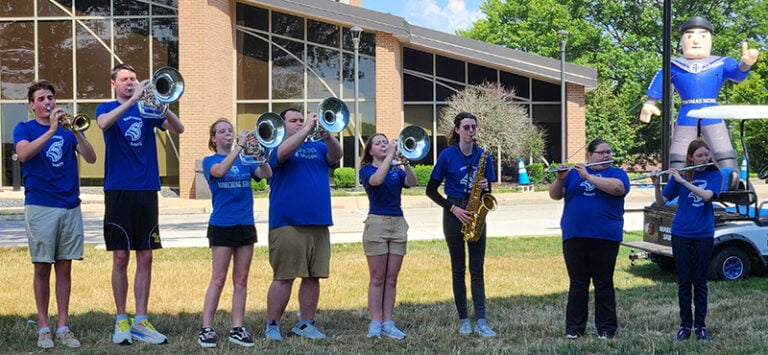Here in the Ohio Valley our summers can be brutal, with so much heat and humidity.
This summer has been exceptionally harsh with heat advisories and air quality alerts issued frequently in recent weeks.
Summer is a prime time for outdoors activities, so during spells of severe weather like we are having now, special precautions should be taken to avoid heat stroke and sunburn.
Use common sense, plan your outdoors activities during the coolest parts of the day, early in the morning, at dusk, at night, or after a pop-up rain shower, when temperatures and humidity levels cool down.
Outdoors enthusiasts at risk for heat-related and sun issues include: anglers, recreational boaters, hikers, trap and skeet shooters, campers, and archers practicing on outdoor ranges for the upcoming bow seasons for deer and wild turkeys.
Rural landowners involved in wildlife management practices — seasonal mowing and planting cover crops for fall use by wildlife — need to be especially careful, too. Heat, sun exposure and insects (mosquitos, biting flies and ticks) are significant problems this time of year.
Heat advisories and air quality alerts

A heat advisory is issued by the National Weather Service when temperatures are expected to be above 90 degreesF and the heat index is going to be near or above 105 degreesF. Temperatures significantly above normal, combined with high humidities can be potentially life threatening, due to heat stroke.
An air quality alert is issued when there are high levels of pollutants in the air. Alerts advise vulnerable groups — the elderly, children, and people with lung disease to take precautions — most notably, stay indoors during peak hours. This summer a major source of pollutants in our region has been smoke from wildfires in Canada, when the winds are from the northeast.
Heat stroke
Heatstroke occurs when your body overheats, and body temperatures rise to 104 degreesF or higher.
According to the Mayo Clinic, heatstroke requires emergency treatment. Untreated heatstroke can quickly damage the brain, heart, kidneys and muscles. The damage worsens the longer treatment is delayed, increasing your risk of serious complications or death.
Signs of heatstroke may include:
• An altered mental state or behavior, such as confusion, agitation, slurred speech, irritability, delirium, seizures and coma.
• Nausea and vomiting.
• Flushed skin. Your skin may turn red as your body temperature increases.
• Rapid breathing, a racing heart rate, and headache.
They suggest that if you think a person may be experiencing heatstroke, seek immediate medical help. Call 911.
Take immediate action to cool the overheated person while waiting for emergency personnel to arrive by getting them into shade or indoors, remove excess clothing, and cool the person with whatever means available. If outdoors, spray with a garden hose.
Indoors the best options are putting them in a cool tub of water or a cool shower, sponge with cool water, fan while misting with cool water, or placing ice packs or cold, wet towels on the person’s head, neck, armpits and groin.
Heatstroke can occur as a result of usually hot weather, strenuous activity, wearing clothing that prevents sweat from evaporating easily and cooling your body, drinking alcoholic beverages, which can affect your body’s ability to regulate your temperature, and becoming dehydrated by not drinking enough water to replenish fluids lost through sweating.
Sunburn
This time of year outdoor enthusiasts usually have a base tan, but that’s no reason to give up on efforts to prevent sunburn.
Here are some tips:
• Wear sunscreen. Dermatologists recommend a sunscreen with a SPF (sun protection factor) of 30 or higher. Apply before you go out in the sun and re-apply every two hours if you are sweating.
• When the sun is bright, it’s a mistake to wear a baseball cap because they don’t cover your ears. A better choice is a wide-brimmed hat.
• Wear light-colored clothing, and stay out of direct sunlight as much as possible.
• Anglers and boaters should consider buying clothing with UV protection.
Anglers and boaters are especially at risk because being on the water compounds sun exposure as the sun’s rays are reflected off rocks and water.

Sunburn is caused by overexposure to Ultraviolet (UV) rays. There are two types of UV radiation — UVA and UVB.
UVA radiation penetrates the top few layers of skin, while UVB radiation penetrates more deeply and can damage the dermis, alter the immune system, and harm the skin’s DNA.
The angle of the sun determines the amount of UV radiation. The greatest risk is at noon, when the sun is directly overhead, but the peak hours of the sun’s intensity extend from about 10:00 a.m. to 4:00 p.m.
Sunburns are painful.
Symptoms vary from person to person. It may take several hours to notice the full effects. Some people get drowsy and their pupils dilate. Minor sunburns typically cause nothing more than slight redness and tenderness.
In more serious cases, blistering can occur. In extreme sunburns, that usually require hospitalization, patients can get fever, chills, nausea, vomit, and feel weak.
Persons with a sunburn should drink plenty of water and take an aspirin. Cool compresses and moisturizing creams and lotions are advisable, to ease the pain, promote healing and lessen peeling, itchy skin.
The body has a normal repair process for sun damaged skin, but over time your skin may become more sensitive to sun exposure.
The effects of sun exposure are cumulative, and sunburns early and often in life, are a risk factor for skin cancer.
The lighter the skin, the higher the risk for skin cancer. Skin cancer occurs most frequently in Caucasians, but can affect all races.
The three most common types of skin cancer are basal cell carcinoma, squamous cell carcinoma and malignant melanoma.
Basal cell carcinoma is most frequently on the head or neck. The lesion is not always tender and will enlarge over time.
It may start out as a red spot or a pearly, translucent bump. Basal cell carcinoma is the most common form of skin cancer, affecting millions of persons a year.
Squamous cell carcinoma is characterized by a tender lesion like a scab, and is rough to the touch.
The third form of skin cancer, malignant melanoma, can be fatal, but is very treatable if detected early. The warning signs are asymmetrical lesions, colored moles, usually dark blue, black, red or brown, moles with a diameter of a pencil eraser, that itch or bleed, and an evolving lesion, that is changing size or color.
Enjoy the outdoors, even in summer’s heat, but be aware of the risks. Stay hydrated, and avoid bright sun. The dangers are real.


















